CBNData jointly released the "2018 Mobile Phone Ordering Trend Insight Report"
In the Internet era, ordering food by mobile phone is bringing new opportunities to the catering industry.
On July 30th, CBNData jointly released the Insight Report on 2018 Mobile Phone Ordering Trend (hereinafter referred to as "Report"). Based on word-of-mouth data, it focused on the latest development of mobile phone ordering in offline catering consumption, gained insight into the consumption characteristics of mobile phone ordering people and interpreted the latest development trend of offline catering.
CBNData "Report" shows that in the past year, the penetration rate of mobile phone ordering in merchants and consumers has increased significantly; Mobile phone ordering users have a high acceptance of fast food and snack catering with higher ordering efficiency; After 85 s and 90 s, they are fans of mobile phone ordering; Mobile phone ordering users are mainly concentrated in first-and second-tier cities. Hangzhou and Shanghai use mobile phones to order food most commonly, and the Yangtze River Delta urban agglomeration is far ahead.
The increase in the penetration rate of mobile phone ordering obviously helps to upgrade catering services.
Food is the most important thing for the people. According to the data of the National Bureau of Statistics, since 2015, the catering industry in China has achieved double-digit growth for three consecutive years, with a scale of nearly 4 trillion yuan. The growth of catering revenue has continuously outperformed the growth of total retail sales of social consumer goods. As aborigines in the Internet age, "post-80s" and "post-90s" have become the backbone of catering consumption, and it is very important for the catering industry to meet the needs of this consumer group through Internet.
The "Report" pointed out that the iterative upgrade of ordering methods is an important embodiment of the Internet in the catering industry, and ordering by mobile phone has become the latest trend to help upgrade catering services.
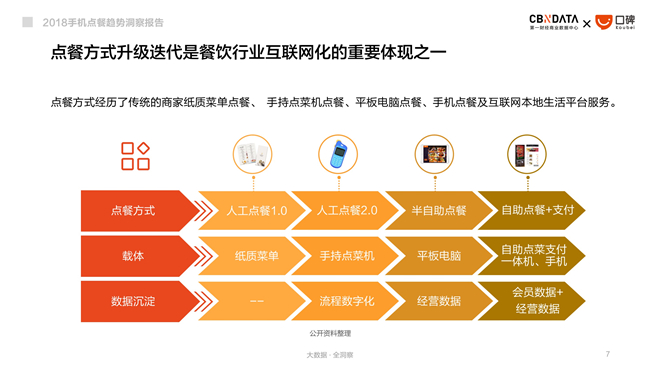
According to the Report, in the past year, the penetration rate of mobile phone ordering in both merchants and consumers has increased significantly. In terms of merchants, taking word-of-mouth platform as an example, compared with the second quarter of 2017, the number of merchant stores using mobile phone ordering function increased by 44% in the first quarter of 2018, and the coverage rate of merchant stores using mobile phone ordering function also increased by about 79%.
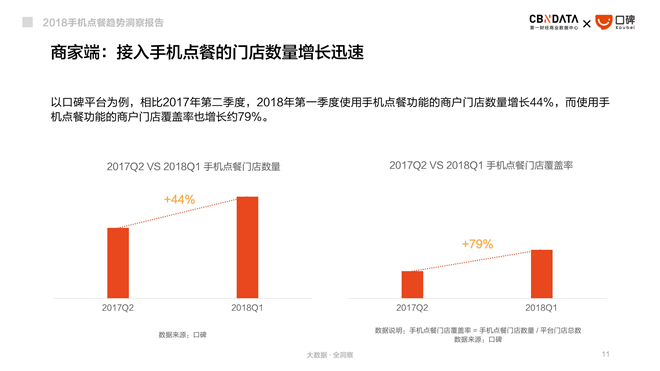
Before arriving at the store, consumers use the word-of-mouth App to order good food in advance, make an appointment and then pick it up at the store; After arriving at the store, consumers can order directly with their mobile phones without queuing. For merchants, the cost reduction and efficiency improvement brought by ordering food by mobile phone are remarkable. On the one hand, this ordering method can optimize the process and improve the turnover rate and service efficiency of the restaurant. On the other hand, it saves labor costs and consumables costs. Taking the comparison of operating costs of "Jindingxuan" before and after ordering food by mobile phone as an example, the labor cost of a single store can be saved by 240,000 a year, and the cost of paper menus can be reduced by 350,000 a year.
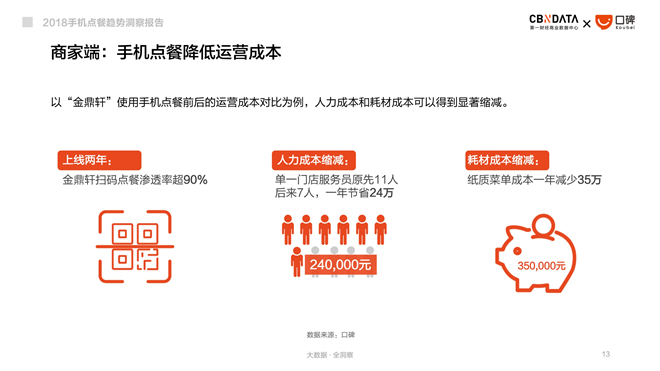
In addition, ordering food by mobile phone has also realized the change from "card" to "person" in member management. Mobile phone ordering and collecting a large amount of consumption data provide more possibilities for restaurants to create refined and intelligent membership services.
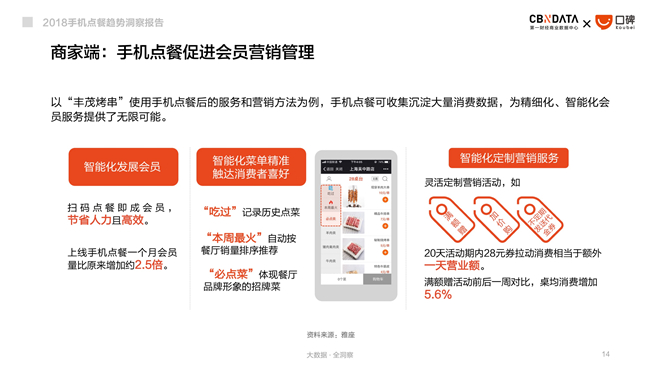
As the function of ordering food by mobile phone has been widely verified, the Report predicts that accessing mobile phone to order food will become the infrastructure for the operation of stores. After experiencing the embryonic stage and the initial stage of development in the past year, the access of mobile phone ordering in catering stores will usher in a period of rapid development in the next year.
Post-80s and post-90s become the main force of the new generation of mobile phone ordering, and have higher acceptance of fast food.
For consumers, ordering food by mobile phone can reduce the waiting time, get real-time discounts, meet their own personalized needs, and significantly improve the dining experience. According to the data of word-of-mouth platform, the number of mobile phone ordering users ushered in a large growth in the third quarter of 2017, which was higher than the growth rate of the overall number of users on the platform. In the first quarter of 2018, the number of users increased by 48% month-on-month, about twice the overall growth rate of the platform. The penetration rate of mobile phone ordering users has also continued to increase. The penetration rate in the first quarter of 2018 is about five times that in the second quarter of 2017.
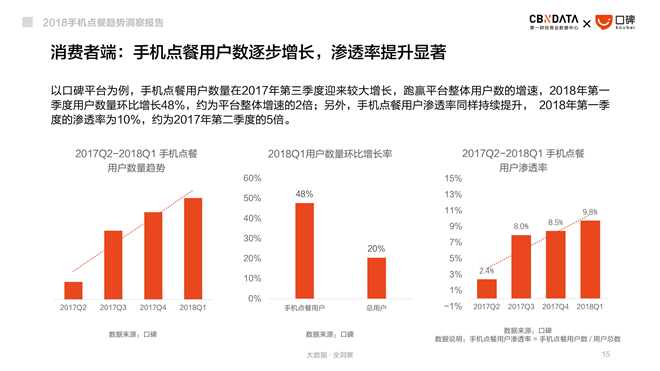
Specifically, young users are the absolute main force of the mobile phone ordering party, and the number of users after 90 is the highest, followed by 85 and 95. The number of women users is also relatively higher than that of men.
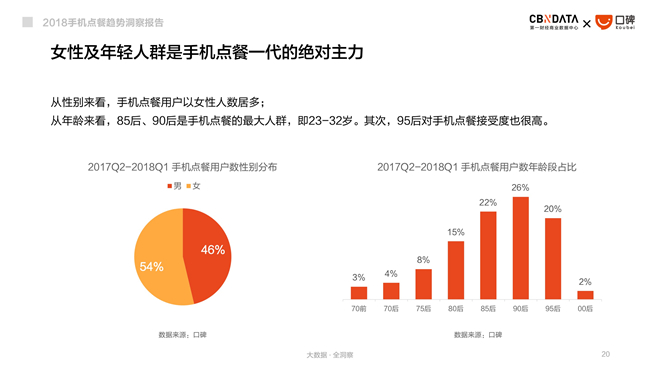
From the peak of the post-90s and post-90s meals, it can be seen that they are new to the society and have not settled down yet, and they eat out and use their mobile phones to order food on weekdays. Moreover, the gap between the weekend catering consumption level of the post-90s and post-90s and the working day is more obvious, indicating that young people who will enjoy life consciously reward themselves and "eat something good" on weekends.
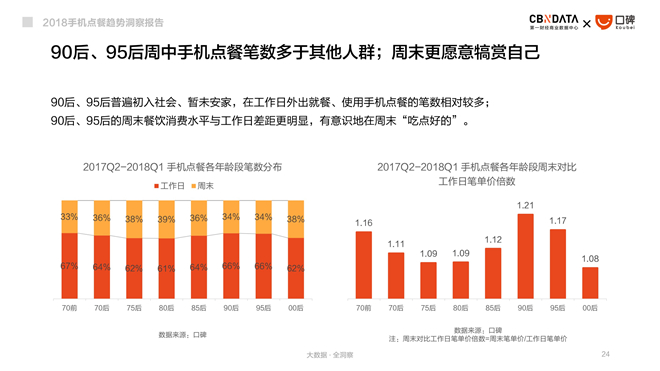
On the whole, mobile phone ordering users have a high acceptance of fast food and snacks, because their products are highly standardized and consumers have higher requirements for ordering efficiency. According to the Report, fast food and snack shops account for 40% of all mobile phone ordering shops, and contribute nearly 80% of mobile phone ordering pens.
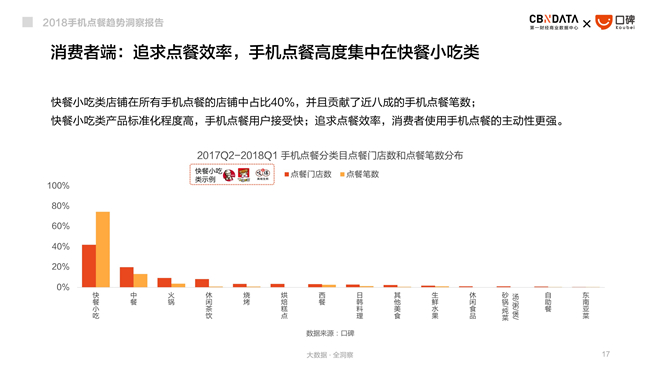
However, this trend is also expanding to other catering categories. According to the report, men’s attempts to order food by mobile phone have expanded from fast food snacks to Chinese food, hot pot, western food and other categories, and after 90, they have expanded from fast food snacks to hot pot and other categories.
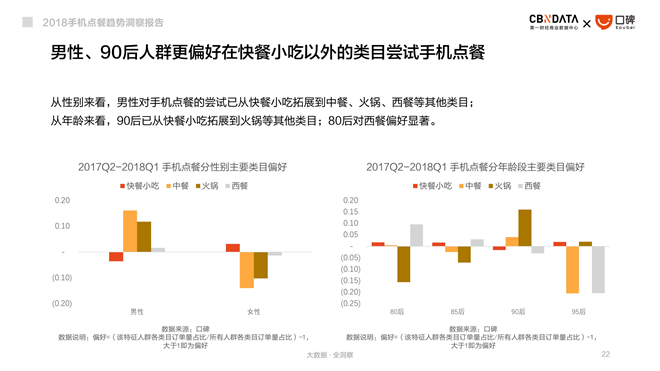
The "Report" pointed out that the new generation of people ordering food by mobile phone is highly coincident with the main group of food and beverage consumption in the store. The post-80s and post-90s’ sensitivity to time and pursuit of quality experience will push back the popularization and optimization of ordering function of mobile phones from consumers.
Hangzhou and Shanghai use mobile phones to order food, and the Yangtze River Delta urban agglomeration is far ahead.
Generally speaking, the fashionable trend starts from first-and second-tier cities, and then gradually spreads to low-tier cities, and mobile phone ordering is no exception. According to the Report, over 60% of mobile phone ordering users are concentrated in first-tier cities and second-tier cities, but the proportion of mobile phone ordering users in third-and fourth-tier cities is increasing.
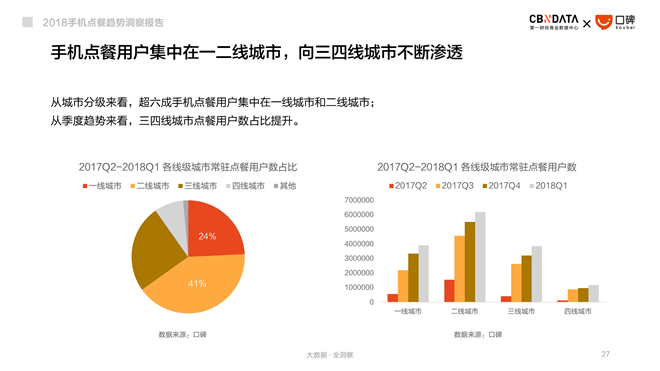
At present, the development of mobile phone ordering in the Yangtze River Delta urban agglomeration can be described as the first. From the perspective of the whole year, the penetration rate of mobile phone ordering in the Yangtze River Delta urban agglomeration is significantly ahead of the Pearl River Delta and Beijing-Tianjin-Hebei urban agglomeration. Since the second quarter of 2017, the penetration rate of the Yangtze River Delta urban agglomeration has increased the fastest, while the Pearl River Delta urban agglomeration is relatively flat.
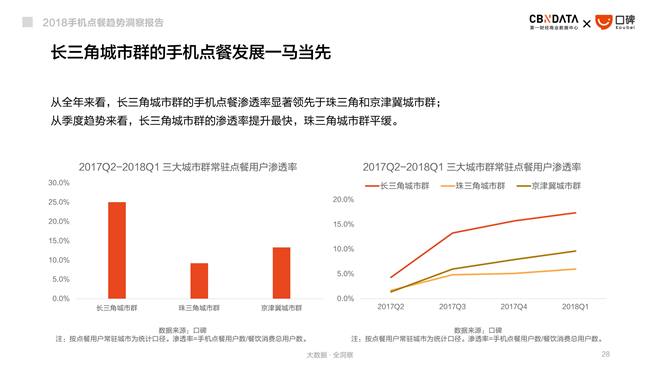
In terms of cities, Hangzhou and Shanghai are the leading cities in mobile phone ordering, and Hangzhou, as the "city of mobile payment", has become the development benchmark in the field of mobile phone ordering. Shanghai residents have used mobile phones to order food, but the frequency of use is not as good as that of Hangzhou, and their habits still need to be cultivated. There are many colleges and universities in Wuhan, and the government actively encourages scientific research and innovation, or promotes the atmosphere of ordering food by mobile phone, so it has become the only central city among the top ten.
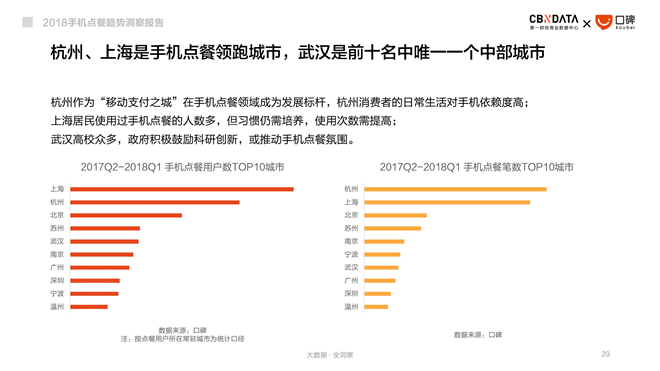
The Report predicts that the advantages of first-and second-tier cities in ordering food by mobile phone will continue. Mobile payment was first popularized in the Yangtze River Delta urban agglomeration, and merchants are highly sensitive to Internet technology, and will still maintain their advantage in ordering food on mobile phones in the short term. Shanghai, which has the largest number of mobile phone orders, and Hangzhou, which has the largest number of mobile phone orders, are currently in the leading position, but it is still unknown who will spend the "first city".